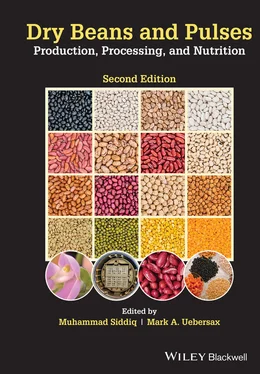Dry Beans and Pulses Production, Processing, and Nutrition
Здесь есть возможность читать онлайн «Dry Beans and Pulses Production, Processing, and Nutrition» — ознакомительный отрывок электронной книги совершенно бесплатно, а после прочтения отрывка купить полную версию. В некоторых случаях можно слушать аудио, скачать через торрент в формате fb2 и присутствует краткое содержание. Жанр: unrecognised, на английском языке. Описание произведения, (предисловие) а так же отзывы посетителей доступны на портале библиотеки ЛибКат.
- Название:Dry Beans and Pulses Production, Processing, and Nutrition
- Автор:
- Жанр:
- Год:неизвестен
- ISBN:нет данных
- Рейтинг книги:5 / 5. Голосов: 1
-
Избранное:Добавить в избранное
- Отзывы:
-
Ваша оценка:
- 100
- 1
- 2
- 3
- 4
- 5
Dry Beans and Pulses Production, Processing, and Nutrition: краткое содержание, описание и аннотация
Предлагаем к чтению аннотацию, описание, краткое содержание или предисловие (зависит от того, что написал сам автор книги «Dry Beans and Pulses Production, Processing, and Nutrition»). Если вы не нашли необходимую информацию о книге — напишите в комментариях, мы постараемся отыскать её.
The second edition of the most complete and authoritative reference on dry beans production, processing, and nutrition available Dry Beans and Pulses: Production, Processing, and Nutrition
Dry Beans and Pulses: Production, Processing, and Nutrition, Second Edition
Dry Beans and Pulses Production, Processing, and Nutrition — читать онлайн ознакомительный отрывок
Ниже представлен текст книги, разбитый по страницам. Система сохранения места последней прочитанной страницы, позволяет с удобством читать онлайн бесплатно книгу «Dry Beans and Pulses Production, Processing, and Nutrition», без необходимости каждый раз заново искать на чём Вы остановились. Поставьте закладку, и сможете в любой момент перейти на страницу, на которой закончили чтение.
Интервал:
Закладка:
Tasleem ZafarDepartment of Food Science & Nutrition College of Life Sciences, Kuwait University Safat, Kuwait.
Preface
Common beans and other pulses are diverse food sources of high nutritional value (protein, energy, fiber, and vitamins and minerals) with broad social acceptance. These legume crops demonstrate global adaptability, genotypic and phenotypic diversity, and multiple means of preparation and dietary use. Beans and pulses are produced in regions as diverse as Latin America, Africa, Asia, and North America. Traditionally, these food crops have not been afforded their due importance to a scale similar to some other crops such as soybean and staple crops, such as wheat, corn, and rice. However, in recent years, pulse crops have gained increased importance due to their value as plant‐based proteins and meat alternatives. Moreover, pulse flours and ingredients are finding new uses in diverse food applications with enhanced nutritional and sensory properties.
Numerous factors influence utilization of grain legumes, including type and cultivar selection, cropping environment and systems, storage conditions and handling infrastructure, processing methods, and final product preparation. Further, nutrient content and bioavailability are dramatically influenced by these diverse factors. In recent years, beans and pulses have been cited for imparting specific positive health potentiating responses, such as hypocholesteremic response, mitigation of diabetes and colorectal cancer, and weight control. Enhanced dry bean utilization focused on improved dietary health is an opportunity within both subsistent and developed populations.
This revised book edition provides a contemporary source of information that brings together current knowledge and practices in the value chain of bean/pulse production, processing, and nutrition. This work provides an in‐depth coverage on a wide variety of pertinent topics: breeding, postharvest technologies, composition, processing technologies, food safety, quality, nutritional profile, significance to human health, and food security. An experienced team of over 50 contributors from North America, Asia, and Africa has written 21 chapters. These contributors come from a field of diverse disciplines, including crop sciences, horticulture, food science and technology, food biochemistry, food engineering, nutritional sciences, Culinology®, environmental sciences, and agricultural extension.
The book is divided into three sections. Part I, Overview, production and postharvest technologies of beans and pulses , contains 5 chapters. Topics include global production and consumption; breeding and production technologies; market classes and physical and physiological characteristics; postharvest handling, packaging and distribution; and storage induced quality defects. Part II, Composition, value‐added processing, and quality , has 12 chapters, which cover composition of processed beans/pulses; hydration, blanching, and thermal processing; canning and canned products; extrusion processing and products; processing of flours and fractions; optical sensing technologies for nondestructive quality assessment; utilization of dry beans and other pulses as ingredients in diverse food products; cowpea processing and products; faba bean processing and nutrition; chickpeas and lentils processing and nutrition; utilization of beans and pulses in Africa; and other common pulses, including mung bean, black gram, pigeon pea, lupin, moth bean and Indian vetch. Part III, Culinology ® , nutrition and significance in human health, and food security , has four chapters, which include culinary perspective of beans and pulses; nutrition and human health benefits; health implications and nutrient bioavailability of bioactive compounds; and roles of dry beans and pulses in global food security. Overall, this value‐chain approach to the presented topics is a distinctive feature of this book.
The editors acknowledge many individuals for their support from conception through final development of this book. Foremost is our sincere thanks and gratitude to all authors for their contributions and for bearing with us during the review and finalization process of their chapters. Thanks are due to Imaad Thasin for providing library and literature search support. We are grateful to our family members for their understanding and support, enabling us to complete this work. We dedicate this work to the worthy contributions of the numerous researchers and students throughout the world for their decades‐long devoted efforts to improving the quality and utilization of dry beans and pulses.
Muhammad Siddiq
Mark A. Uebersax
1 Global Production, Trade, Processing and Nutritional Profile of Dry Beans and Other Pulses
Muhammad Siddiq Mark A. Uebersax and Farihah Siddiq
Introduction History and origin
Production and trade Global production and trade US production and trade
Consumption trends of dry beans
Dry beans and other pulses as a diverse food resource Traditional utilization Value‐added processing and products
Nutritional profile and health benefits Nutritional profile Health benefits Beans and pulses use in weaning foods
Constraints to utilization of beans and other pulses
Legumes and sustainability of agricultural systems
Beans and other pulses in world food security Dry beans in food aid programs
Summary
References
INTRODUCTION
Legumes (dry beans and other pulses) occupy an important place in human nutrition, especially among the low‐income groups of people in developing countries. Although terms legumes, pulses, and beans are used interchangeably, they have distinct meanings. For example, a legume refers to any plant from the Fabaceae family, including leaves, stems, and pods, while edible seeds from the legume plant are called pulses, which include beans, cowpeas, chickpeas, lentils, and peas, to name a few (HSPH 2020; Perera et al. 2020). Food legumes have significant importance in human diet and animal feed worldwide and occupy an important place in the global food supply chain besides promoting sustainable agricultural production systems (Pratap et al. 2021).
Legumes typically have pea‐blossom type flowers, herbaceous to woody stems, a generally well‐defined taproot, nitrogen‐assimilating bacteria within nodules associated with the fibrous root system, bivalved seeds in varying numbers borne in single‐celled pods that readily separate into halves at maturity, an annual lifecycle, and grow throughout the world from the tropics to high mountainous regions (Hardenburg 1927). Legume plants serve as hosts for nitrogen‐fixing bacteria ( Rhizobium ) through symbiotic colonization within nodules that develop among the plant root system. Thus, legume crops are soil nutrient enhancers that build soil nitrogen levels through suitable crop rotations of legumes with non‐nitrogen fixing cereal grains (Bliss 1993; Martinez‐Romero 2003).
Dry beans and other pulses are a good source of protein (significantly higher than that of cereals), dietary fiber, starch, minerals, and vitamins (Kutos et al. 2002; Hayat et al. 2014; Kamboj and Nanda 2018). They are a staple food and are a low‐cost source of protein in developing countries where protein energy malnutrition (PEM) is prevalent (Van Heerden and Schonfeldt 2004). The inclusion of pulses in the daily diet has many beneficial physiological effects in controlling and preventing various metabolic diseases such as diabetes mellitus, coronary heart disease, and colon cancer (Tharanathan and Mahadevamma 2003). Further, pulses belong to the group that elicits the lowest blood glucose response and contain considerable contents of phenolic compounds. The role of legumes as therapeutic agents in the diets of persons suffering from metabolic disorders has gained a significant interest in recent years (Mudryj et al. 2014; Yao et al. 2020).
Читать дальшеИнтервал:
Закладка:
Похожие книги на «Dry Beans and Pulses Production, Processing, and Nutrition»
Представляем Вашему вниманию похожие книги на «Dry Beans and Pulses Production, Processing, and Nutrition» списком для выбора. Мы отобрали схожую по названию и смыслу литературу в надежде предоставить читателям больше вариантов отыскать новые, интересные, ещё непрочитанные произведения.
Обсуждение, отзывы о книге «Dry Beans and Pulses Production, Processing, and Nutrition» и просто собственные мнения читателей. Оставьте ваши комментарии, напишите, что Вы думаете о произведении, его смысле или главных героях. Укажите что конкретно понравилось, а что нет, и почему Вы так считаете.












